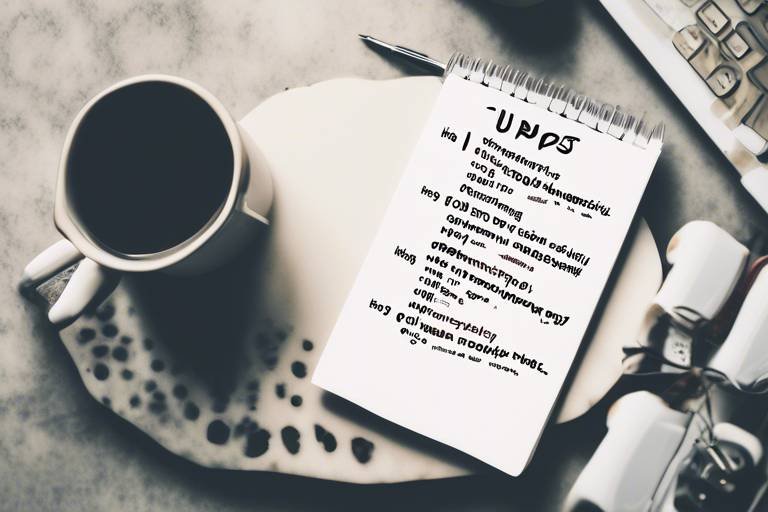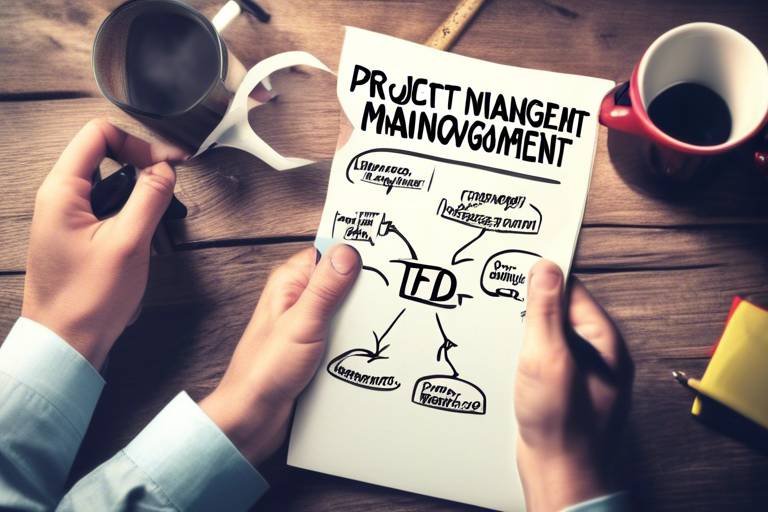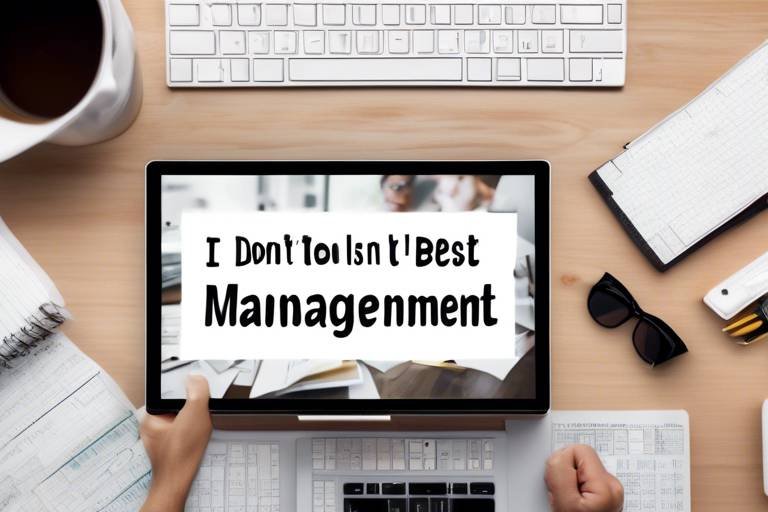Tips for Maintaining High Productivity Levels with a Busy Schedule
Are you struggling to maintain high productivity levels amidst a jam-packed schedule? Balancing work, personal commitments, and other responsibilities can be challenging, but with the right strategies, you can boost efficiency and focus in your daily tasks. Let's explore some valuable tips to help you stay productive even when your calendar is overflowing.

Prioritize Tasks Wisely
When faced with a busy schedule, it's crucial to prioritize tasks wisely to ensure that your time and energy are focused on what truly matters. By identifying high-priority tasks, you can maximize productivity and make significant progress towards your goals.
One effective way to prioritize tasks is to categorize them based on urgency and importance. Urgent tasks require immediate attention, while important tasks contribute significantly to your long-term objectives. By distinguishing between the two, you can allocate your resources efficiently and tackle critical tasks first.
Moreover, using the Eisenhower Matrix can help you prioritize tasks effectively. This method classifies tasks into four quadrants: urgent and important, important but not urgent, urgent but not important, and neither urgent nor important. By organizing your tasks in this manner, you can focus on what truly matters and avoid getting bogged down by less crucial activities.
Additionally, consider the 80/20 rule, also known as the Pareto Principle, which suggests that 80% of your results come from 20% of your efforts. By identifying the tasks that yield the most significant outcomes, you can prioritize them and achieve optimal results even in a busy schedule.
Remember, effective task prioritization is not about doing more tasks but about doing the right tasks at the right time. By focusing on high-priority activities and minimizing distractions, you can enhance your productivity and make the most of your hectic schedule.

Time Blocking Techniques
Time blocking is a powerful productivity technique that involves scheduling specific blocks of time for different tasks or activities throughout the day. By segmenting your day into dedicated time slots for work, meetings, breaks, and personal activities, you can enhance focus, efficiency, and organization in your daily routine.
One effective time blocking technique is to create a detailed schedule outlining the tasks you need to accomplish and allocating specific time periods to work on each task. This structured approach helps you prioritize important activities and ensures that you devote adequate time and attention to each task without distractions.
Additionally, using tools such as digital calendars or productivity apps can assist in visualizing your time blocks and setting reminders for upcoming tasks or transitions between activities. By adhering to your time blocks and respecting the allocated time for each task, you can avoid procrastination and improve time management skills.
Moreover, incorporating buffer time between time blocks allows for flexibility in case tasks take longer than expected or unexpected interruptions arise. This buffer time provides a cushion for adjusting your schedule without causing major disruptions to your overall productivity.
By implementing time blocking techniques effectively, you can optimize your daily schedule, reduce decision fatigue, and increase productivity by focusing on one task at a time. This method not only enhances efficiency but also helps in maintaining a sense of accomplishment as you progress through your planned activities.

Effective Goal Setting
Setting effective goals is crucial for maintaining productivity and focus, especially in the midst of a busy schedule. When it comes to goal setting, it's essential to first define what you want to achieve and break it down into smaller, manageable tasks. By setting clear and achievable goals, you create a roadmap that guides your actions and keeps you motivated.
One effective strategy is to use the SMART criteria for goal setting. This approach ensures that your goals are Specific, Measurable, Achievable, Relevant, and Time-bound. By following these criteria, you can create goals that are clear, quantifiable, realistic, aligned with your objectives, and have a deadline for completion.
Moreover, it's beneficial to prioritize your goals based on their importance and urgency. By categorizing your goals into short-term and long-term objectives, you can focus on what needs immediate attention while also working towards more significant achievements in the future. This approach helps in managing your time effectively and staying on track with your progress.
Additionally, visualizing your goals can be a powerful motivator. Creating a vision board or using a goal-tracking app can help you see your objectives clearly and monitor your advancement. This visual representation serves as a constant reminder of what you're aiming for and encourages you to stay committed to your goals.
Remember, effective goal setting is not just about what you want to accomplish but also about how you plan to get there. By breaking down your goals into actionable steps, staying accountable, and regularly reviewing your progress, you set yourself up for success even in the busiest of schedules.

Healthy Work-Life Balance
When it comes to maintaining high productivity levels in a busy schedule, achieving a healthy work-life balance is crucial. Imagine your life as a scale, with work on one side and personal time on the other. Just like a balanced scale ensures stability, a well-managed work-life balance promotes overall well-being and prevents burnout. It's like nurturing a plant - too much sunlight (work) can cause it to wither, while enough sunlight and water (personal time) help it thrive.
One effective strategy for establishing a healthy work-life balance is setting boundaries. Just as you allocate time for work tasks, designate specific periods for personal activities and relaxation. This separation allows you to fully engage in both work and personal life without one encroaching on the other. It's like having designated lanes on a road - each serving its purpose and ensuring smooth traffic flow.
Additionally, incorporating self-care practices into your routine is essential for maintaining balance. Whether it's exercise, meditation, hobbies, or spending quality time with loved ones, these activities rejuvenate your mind and body, enhancing your overall well-being. It's like recharging a battery - taking the time to replenish your energy levels ensures sustained performance and longevity.
Effective time management plays a significant role in achieving a healthy work-life balance. By prioritizing tasks, utilizing time blocking techniques, and leveraging technology tools, you can optimize your workflow and create space for personal time. Remember, it's not about working harder but working smarter to make time for what truly matters outside of work. It's like fitting puzzle pieces together - each task finding its place in your schedule to create a harmonious picture.
In conclusion, maintaining a healthy work-life balance is essential for sustaining productivity and well-being in a busy schedule. By setting boundaries, practicing self-care, managing time effectively, and prioritizing personal time, you can create a harmonious blend of work and life. Just like a well-conducted orchestra, where each instrument plays its part in creating a beautiful symphony, a balanced work-life dynamic leads to a fulfilling and successful lifestyle.

Utilizing Technology Tools
When it comes to managing a busy schedule and maintaining high productivity levels, utilizing technology tools can be a game-changer. In today's digital age, there is a wide range of productivity apps and software designed to help individuals stay organized, focused, and efficient amidst their hectic routines.
One key benefit of technology tools is their ability to streamline tasks and automate processes, saving valuable time and reducing manual effort. Whether it's project management software, task tracking apps, or calendar tools, these applications can help individuals stay on top of their responsibilities and deadlines without feeling overwhelmed.
Moreover, technology tools can also aid in time management by enabling users to set reminders, schedule notifications, and create digital to-do lists. By leveraging these features, individuals can prioritize their tasks effectively and ensure that nothing falls through the cracks in the midst of a busy schedule.
Additionally, technology tools provide valuable insights and analytics that can help users track their progress, identify areas for improvement, and optimize their workflow. By analyzing data on their productivity levels and time usage, individuals can make informed decisions on how to better allocate their resources and enhance their efficiency.
Furthermore, collaboration tools and communication platforms can facilitate seamless interaction with colleagues, clients, and team members, even when everyone is working remotely or on different schedules. By leveraging technology for effective communication, individuals can ensure that projects move forward smoothly and deadlines are met without delays.
In conclusion, the effective utilization of technology tools is essential for staying productive and organized in a busy schedule. By embracing the power of digital solutions, individuals can streamline their workflow, manage their time efficiently, and enhance their overall productivity levels, ultimately leading to greater success and satisfaction in both their personal and professional lives.

Regular Breaks and Rest
Regular breaks and rest are essential components of maintaining high productivity levels, especially when dealing with a busy schedule. Just like a well-oiled machine needs regular maintenance to function optimally, our minds and bodies require periodic breaks to recharge and operate efficiently.
Imagine your mind as a computer that needs to be restarted periodically to clear out clutter and run smoothly. By taking short breaks throughout the day, you allow your brain to reset, refocus, and come back to tasks with renewed energy and clarity.
Studies have shown that working for extended periods without breaks can lead to decreased productivity and increased stress levels. It's like trying to drive a car without ever stopping for fuel or maintenance – eventually, it will break down.
One effective technique is the Pomodoro method, where you work for a set period, typically 25 minutes, and then take a short break. This structured approach not only helps in maintaining focus but also prevents burnout by incorporating regular intervals of rest.
Additionally, incorporating physical activity or mindfulness practices during breaks can further enhance productivity. Whether it's a short walk outside, stretching exercises at your desk, or a brief meditation session, these activities can rejuvenate both your body and mind.
Remember, productivity is not about working non-stop; it's about working smart. By prioritizing regular breaks and rest in your busy schedule, you can sustain high levels of efficiency, creativity, and overall well-being.

Effective Communication Strategies
Effective communication is essential for managing tasks efficiently and collaborating with others in a busy schedule. Clear and concise communication helps in avoiding misunderstandings and ensures that everyone is on the same page. By utilizing active listening skills and open communication channels, individuals can streamline processes and enhance productivity.
Moreover, delegation plays a crucial role in effective communication strategies. By delegating tasks based on team members' strengths and expertise, work can be distributed evenly, allowing for a more efficient workflow. Establishing clear expectations and providing regular feedback also contribute to effective communication within a busy schedule.
Additionally, utilizing collaboration tools and platforms can facilitate communication and project management, especially when working with remote teams or across different time zones. These tools enable real-time interaction, file sharing, and seamless coordination, enhancing productivity despite the challenges of a hectic schedule.

Continuous Learning and Improvement
Continuous learning and improvement are essential components for individuals striving to maintain high productivity levels in a busy schedule. Just like a skilled craftsman hones their tools to perfection, continuous learning sharpens our minds and abilities, enabling us to navigate challenges with finesse.
Embracing a growth mindset, where each experience is seen as an opportunity to learn and grow, fosters resilience and adaptability in the face of changing circumstances. It's akin to planting seeds of knowledge that blossom into a garden of expertise, enriching both our personal and professional lives.
By seeking out new knowledge, acquiring fresh skills, and staying abreast of industry trends, individuals can stay ahead of the curve and remain competitive in today's dynamic work environment. Learning doesn't stop at a certain age or stage of one's career; it is a lifelong journey that fuels innovation and drives progress.
Moreover, continuous improvement involves reflecting on past experiences, identifying areas for enhancement, and actively seeking ways to refine our processes and approaches. It's like fine-tuning a musical instrument to produce harmonious melodies; each adjustment brings us closer to achieving mastery in our endeavors.
Collaboration and knowledge sharing play a significant role in the process of continuous learning and improvement. Engaging with peers, mentors, and industry experts allows for the exchange of ideas, feedback, and best practices, fostering a culture of growth and innovation.
Ultimately, embracing a mindset of continuous learning and improvement empowers individuals to adapt to change, overcome obstacles, and unlock their full potential. It's a journey of self-discovery and transformation, where each lesson learned propels us towards greater heights of success and fulfillment.
Frequently Asked Questions
- How can I effectively prioritize tasks with a busy schedule?
One effective way to prioritize tasks is to identify high-priority items that align with your goals and focus on completing those first. Breaking down tasks into smaller, manageable steps can also help in organizing your workload and tackling important responsibilities efficiently.
- What are some recommended time blocking techniques to enhance productivity?
Time blocking involves setting specific time slots for different activities or tasks throughout the day. By allocating dedicated blocks of time for focused work, meetings, breaks, and personal activities, you can improve time management, reduce distractions, and maintain productivity levels.
- How can I maintain a healthy work-life balance amidst a busy schedule?
Creating boundaries between work and personal time is essential for maintaining a healthy balance. Prioritizing self-care, setting realistic work hours, and learning to delegate tasks when necessary can help prevent burnout and promote overall well-being in a busy schedule.
- What are the benefits of utilizing technology tools for productivity?
Productivity apps and tools can streamline tasks, automate repetitive processes, and provide reminders for deadlines and important events. By leveraging technology effectively, you can stay organized, save time, and increase efficiency in managing your workload.
- How important are regular breaks and rest in maintaining productivity levels?
Taking regular breaks and incorporating rest periods into your schedule is crucial for recharging your energy, improving focus, and preventing mental fatigue. Short breaks can enhance creativity, productivity, and overall well-being, even in a busy work environment.


















